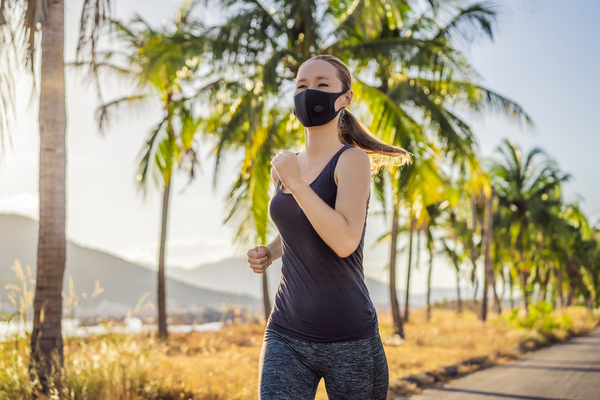The Centers for Disease Control and Prevention (CDC 2020) presently recommends that everyone wear a cloth face covering (mask) in public settings, where other social distancing measures are difficult to maintain in order to slow the spread of COVID-19. Exercise centers, gyms and fitness studios are now starting to re-open as the stay-at-home directives begin to ease throughout the U.S. and other countries. Exercise enthusiasts are wondering if it is safe to return to their favorite workout facility and what precautions need to be in place for everyone to remain safe. With no COVID-19 national safety directives in place for all gyms and exercise facilities, policies are sure to vary throughout the country and among fitness businesses. One big question being asked by fitness pros and exercise enthusiasts is, “Should I wear a face mask when I workout in a fitness facility?”
Most people can perform their regular workouts while wearing a face covering, which will provide protection from virus spread for everyone. It is essential to remind exercise enthusiasts to monitor how they feel during the workout and to take particular notice if they feel dizzy, lightheaded, or short of breath. If so, slow down/reduce exercise intensity and or stop exercising until these symptoms go away. If anyone has to stop exercising due to shortness of breath and he or she remains short of breath, have the person remove the covering to allow for better air flow into the lungs. Remember, these symptoms (i.e., dizziness, lightheadedness, shortness of breath) during exercise may also reflect a number of health conditions including the following: overexertion (particularly if a person hasn’t worked out for some time or at his or her usual intensity levels, due to stay-at-home rules), dehydration, low blood pressure, low blood glucose, heart arrhythmia (sometimes exercise triggers an irregular heart rhythm) or lack of oxygen.
Individuals with a pre-existing respiratory or cardiovascular condition are encouraged to take caution when exercising with a face mask. Specifically, those who have chronic obstructive pulmonary disorder, asthma, chronic bronchitis, pulmonary fibrosis and any other lung conditions should consult (i.e., via telemedicine) with a medical professional for personal instructions on exercising with a face mask.
Also, feeling dizzy after a workout (with or without wearing a face mask) may indicate that a person has low blood pressure. This may also occur in pregnant women. Dizziness after exercise may sometimes indicate a heart problem or symptoms of type 2 diabetes (low blood sugar levels). Medical attention is necessary if this condition persists.
Monitoring exercise intensity is always essential for a safe and effective workout, with or without wearing a face covering. However, wearing any type of covering over the nose and mouth while exercising is likely to reduce the flow of oxygen into your lungs. Some exercisers who wear face masks may notice they are not able to complete an otherwise “normal” workout, or they feel more fatigued than usual during and after the workout.
To minimize early symptoms of fatigue during exercise with a face mask, initially, don’t push yourself as hard as usual. Experts say to monitor your perceived exertion rate and give your cardiorespiratory system time to gradually adapt to the slight restriction of air flow (from the face mask). Fitness adaptations to changes in overload during workout programs usually take weeks to occur. It may take several workouts before you are fully training at your regular exercise intensities.
As for the type of face mask that’s best to wear during a workouts, remember that the purpose of the face mask is to help block respiratory droplets from being sprayed into the air when a person coughs, sneezes, breathes or talks. Covering your face with a scarf, bandana or T-shirt are not a great option, because they are too thin and usually do not fit the face well. If you have an N95, great, if you can find one. Cloth masks work well as long as they fit your face fully from chin to over the bridge of the nose, flush to the skin at the sides, and have more than one layer of fabric. Some fitness manufacturers like Adidas, Fila, Reebok, Under Armour, Athleta, Champion, and others, have all started making masks for active lifestyles. A neck gaiter (also called a buff) is a flexible tube fabric worn to keep the neck and face warm in cold weather. Neck gaiters are not a good option for exercise enthusiasts because they are designed to keep the face and neck warm, and during exercise it is important to dissipate heat from the body (to cool it off), although some manufacturers now make gators with a cooling technology, designed to cool you down when your body heats up (Mission Max Cooling Neck Gaiters are available at Dick’s Sporting Goods). Experts say to avoid using masks that have plastic valves in the front, as these only filter air that a person breathes in and does not block the air breathed out (Sweeney, 2020). Finally, face shields offer yet another face covering option for exercisers. Face shields provide wearers protection (entire face—eyes, nose and mouth) without impacting breathing. The downside is that face shields can be a hindrance to movement and tend to be less available than other face-covering options.
Finally, when exercising, face masks should be looked at as a barrier, not a complete shield, in terms of blocking virus particles. Therefore, whenever possible, social distancing measures should always be adhered to in the gym, and commonly touched surfaces should be routinely sanitized. The outside of the mask may become contaminated, so they should not touch it and instead use correct safety measures when removing it, to avoid negatively impacting the positive health effects of the mask. Lastly, it is important to regularly check the CDC and World Health Organization (WHO) websites for updated recommendations on preventive measures.
—
Photo Credit: Elizaveta Galitckaia / Shutterstock.com
